Allen Butler Talcott on:
[Wikipedia]
[Google]
[Amazon]
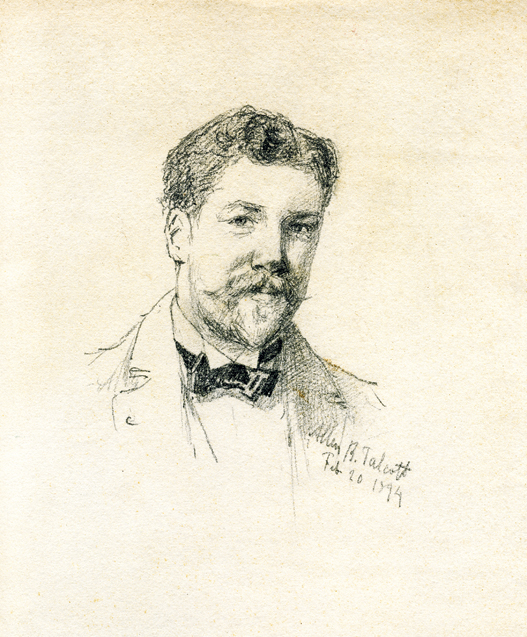 Allen Butler Talcott (April 8, 1867 – June 1, 1908) was an American landscape painter. After studying art in Paris for three years at Académie Julian, he returned to the United States, becoming one of the first members of the Old Lyme Art Colony in Connecticut. His paintings, usually landscapes depicting the local scenery and often executed ''
Allen Butler Talcott (April 8, 1867 – June 1, 1908) was an American landscape painter. After studying art in Paris for three years at Académie Julian, he returned to the United States, becoming one of the first members of the Old Lyme Art Colony in Connecticut. His paintings, usually landscapes depicting the local scenery and often executed ''
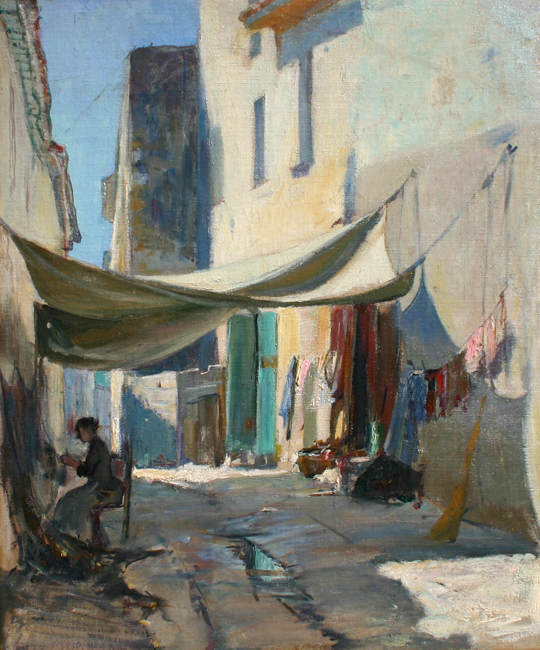 Allen Butler Talcott was born on April 8, 1867, in Hartford, Connecticut, into an established and prominent New England family. His artistic inclinations were apparent at an early age, as he created sketches of teachers and fellow students in the margins of his grade school books.
He attended
Allen Butler Talcott was born on April 8, 1867, in Hartford, Connecticut, into an established and prominent New England family. His artistic inclinations were apparent at an early age, as he created sketches of teachers and fellow students in the margins of his grade school books.
He attended
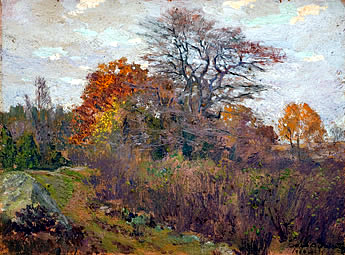 Talcott lived in
Talcott lived in  Talcott bought an Old Lyme estate looking out upon the Connecticut River in 1903. Around this time, Hassam was bringing Impressionism to the colony, and many of the artists including Talcott began moving in that direction. He did not, however, fully adopt the principles of Impressionism, instead integrating certain aspects into his Tonalist paintings. He retained the Tonalist interest in a unified set of colors, while incorporating the Impressionist concentration on the effects of light by lightening his palette. While lighter than Ranger's, Talcott's colors were still subdued compared to those of the Impressionists. The nature of his brushstrokes also changed, becoming more "flickery". In addition to Hassam, DuMond also influenced him artistically.
Talcott bought an Old Lyme estate looking out upon the Connecticut River in 1903. Around this time, Hassam was bringing Impressionism to the colony, and many of the artists including Talcott began moving in that direction. He did not, however, fully adopt the principles of Impressionism, instead integrating certain aspects into his Tonalist paintings. He retained the Tonalist interest in a unified set of colors, while incorporating the Impressionist concentration on the effects of light by lightening his palette. While lighter than Ranger's, Talcott's colors were still subdued compared to those of the Impressionists. The nature of his brushstrokes also changed, becoming more "flickery". In addition to Hassam, DuMond also influenced him artistically.
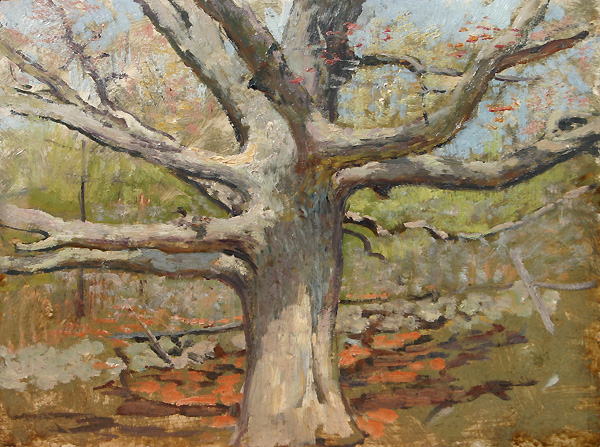 Although he created some portraits, for example, of family members, his subject matter consisted primarily of
Although he created some portraits, for example, of family members, his subject matter consisted primarily of
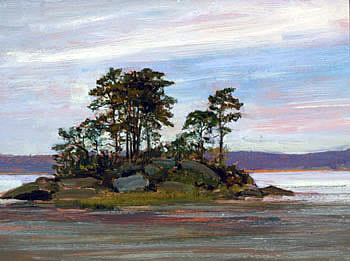 In 1905, Allen married Katherine Nash Agnew, daughter of New York physician Cornelius Rea Agnew, and they had a son, Agnew. Talcott's uncles, John Butler Talcott and
In 1905, Allen married Katherine Nash Agnew, daughter of New York physician Cornelius Rea Agnew, and they had a son, Agnew. Talcott's uncles, John Butler Talcott and
File:Evening, Allen Butler Talcott.jpg, ''Evening''
File:Oak Tree and Marshland, Allen Butler Talcott.jpg, ''Oak Tree and Marshland'', left panel detail
File:Oak Tree and Marshland, right panel, Allen Butler Talcott.jpg, ''Oak Tree and Marshland'', right panel detail
File:Path Through the Woods, Allen Butler Talcott.jpg, ''Path Through the Woods''
File:Spreading Oak, Allen Butler Talcott.jpg, ''Spreading Oak''
File:The Bright Light of Autumn, Allen Butler Talcott.jpg, ''The Bright Light of Autumn''
 Allen Butler Talcott (April 8, 1867 – June 1, 1908) was an American landscape painter. After studying art in Paris for three years at Académie Julian, he returned to the United States, becoming one of the first members of the Old Lyme Art Colony in Connecticut. His paintings, usually landscapes depicting the local scenery and often executed ''
Allen Butler Talcott (April 8, 1867 – June 1, 1908) was an American landscape painter. After studying art in Paris for three years at Académie Julian, he returned to the United States, becoming one of the first members of the Old Lyme Art Colony in Connecticut. His paintings, usually landscapes depicting the local scenery and often executed ''en plein air
''En plein air'' (; French for 'outdoors'), or ''plein air'' painting, is the act of painting outdoors.
This method contrasts with studio painting or academic rules that might create a predetermined look. The theory of 'En plein air' painting ...
'', were generally Barbizon
Barbizon () is a commune (town) in the Seine-et-Marne department in north-central France. It is located near the Fontainebleau Forest.
Demographics
The inhabitants are called ''Barbizonais''.
Art history
The Barbizon school of painters is nam ...
and Tonalist, sometimes incorporating elements of Impressionism
Impressionism was a 19th-century art movement characterized by relatively small, thin, yet visible brush strokes, open composition, emphasis on accurate depiction of light in its changing qualities (often accentuating the effects of the passage ...
. He was especially known and respected for his paintings of trees. After eight summers at Old Lyme, he died there at the age of 41.
Early life and education
 Allen Butler Talcott was born on April 8, 1867, in Hartford, Connecticut, into an established and prominent New England family. His artistic inclinations were apparent at an early age, as he created sketches of teachers and fellow students in the margins of his grade school books.
He attended
Allen Butler Talcott was born on April 8, 1867, in Hartford, Connecticut, into an established and prominent New England family. His artistic inclinations were apparent at an early age, as he created sketches of teachers and fellow students in the margins of his grade school books.
He attended Trinity College Trinity College may refer to:
Australia
* Trinity Anglican College, an Anglican coeducational primary and secondary school in , New South Wales
* Trinity Catholic College, Auburn, a coeducational school in the inner-western suburbs of Sydney, New ...
in Hartford, receiving a diploma in 1890. While there, he was a member of the Fraternity of Delta Psi ( St. Anthony Hall). His formal art education began at the Hartford Art Society, where he studied with painter Dwight William Tryon
Dwight William Tryon (August 13, 1849 – July 1, 1925) was an American landscape painter in the late 19th and early 20th centuries. His work was influenced by James McNeill Whistler, and he is best known for his landscapes and seascapes pai ...
. He moved to Manhattan while he studied for a short time at the Art Students League of New York. Then he attended Académie Julian in Paris for three years, studying under Jean-Paul Laurens
Jean-Paul Laurens (; 28 March 1838 – 23 March 1921) was a French painter and sculptor, and one of the last major exponents of the French Academic style.
Biography
Laurens was born in Fourquevaux and was a pupil of Léon Cogniet and Alexa ...
and Benjamin Constant
Henri-Benjamin Constant de Rebecque (; 25 October 1767 – 8 December 1830), or simply Benjamin Constant, was a Franco-Swiss political thinker, activist and writer on political theory and religion.
A committed republican from 1795, he backed t ...
. His work received its first artistic recognition during this period in France, as his paintings were exhibited at the 1893 and 1894 Paris Salons.
Work
 Talcott lived in
Talcott lived in Arles
Arles (, , ; oc, label= Provençal, Arle ; Classical la, Arelate) is a coastal city and commune in the South of France, a subprefecture in the Bouches-du-Rhône department of the Provence-Alpes-Côte d'Azur region, in the former province of ...
in 1897, renting Vincent van Gogh
Vincent Willem van Gogh (; 30 March 185329 July 1890) was a Dutch Post-Impressionist painter who posthumously became one of the most famous and influential figures in Western art history. In a decade, he created about 2,100 artworks, inc ...
's house, along with Frank DuMond
Frank Vincent DuMond (August 20, 1865 – February 6, 1951) was one of the most influential teacher-painters in 20th-century America. He was an illustrator and American Impressionist painter of portraits and landscapes, and a prominent teach ...
. He came home to Hartford, where he set up a studio, which he maintained for a few years. He also returned to New York, joining a cooperative studio complex which had been established by Henry Ward Ranger
Henry Ward Ranger (January 29, 1858 – November 7, 1916) was an American artist. Born in western New York State, he was a prominent landscape and marine painter, an important Tonalist, and the leader of the Old Lyme Art Colony. Ranger became a ...
. Ranger became friends with Talcott, as well as an influence. Ranger was also founder of the Old Lyme Art Colony in Connecticut, and Talcott became one of the first artists to join. When he first arrived in 1901, he stayed at Florence Griswold
Florence Ann Griswold (December 25, 1850 – December 6, 1937) was a resident of Old Lyme, Connecticut, United States who became the nucleus of the " Old Lyme Art Colony" in the early 20th century. Her home has since been made into the Florenc ...
's boarding house, which would later be turned into an art museum. He worked in his New York City studio during the winters, and spent his summers at Old Lyme for eight years, until his death there in 1908.
Barbizon
Barbizon () is a commune (town) in the Seine-et-Marne department in north-central France. It is located near the Fontainebleau Forest.
Demographics
The inhabitants are called ''Barbizonais''.
Art history
The Barbizon school of painters is nam ...
art was popular with artists in the U.S. during this period. Among Ranger and other Old Lyme artists, a variant, Tonalism
Tonalism was an artistic style that emerged in the 1880s when American artists began to paint landscape forms with an overall tone of colored atmosphere or mist. Between 1880 and 1915, dark, neutral hues such as gray, brown or blue, often domina ...
, evolved in which the palette consisted of just a few muted colors. Talcott had gained a fondness for French Impressionism
Impressionism was a 19th-century art movement characterized by relatively small, thin, yet visible brush strokes, open composition, emphasis on accurate depiction of light in its changing qualities (often accentuating the effects of the passage ...
and was exposed to its American equivalent at Cos Cob
Cos Cob is a neighborhood and census-designated place in the town of Greenwich, Connecticut. It is located on the Connecticut shoreline in southern Fairfield County. It had a population of 6,770 at the 2010 census.
Cos Cob is located on the west ...
, Connecticut, in the late 1890s. There, artists such as Childe Hassam
Frederick Childe Hassam (; October 17, 1859 – August 27, 1935) was an American Impressionist painter, noted for his urban and coastal scenes. Along with Mary Cassatt and John Henry Twachtman, Hassam was instrumental in promulgating Impressioni ...
and John Henry Twachtman
John Henry Twachtman (August 4, 1853 – August 8, 1902) was an American painter best known for his impressionist landscapes, though his painting style varied widely through his career. Art historians consider Twachtman's style of American Impr ...
were developing the artistic style. But Ranger and Tryon were stronger influences on Talcott, and his early paintings are primarily Barbizon and Tonalist – landscapes in shades of brown, green and gold.
 Talcott bought an Old Lyme estate looking out upon the Connecticut River in 1903. Around this time, Hassam was bringing Impressionism to the colony, and many of the artists including Talcott began moving in that direction. He did not, however, fully adopt the principles of Impressionism, instead integrating certain aspects into his Tonalist paintings. He retained the Tonalist interest in a unified set of colors, while incorporating the Impressionist concentration on the effects of light by lightening his palette. While lighter than Ranger's, Talcott's colors were still subdued compared to those of the Impressionists. The nature of his brushstrokes also changed, becoming more "flickery". In addition to Hassam, DuMond also influenced him artistically.
Talcott bought an Old Lyme estate looking out upon the Connecticut River in 1903. Around this time, Hassam was bringing Impressionism to the colony, and many of the artists including Talcott began moving in that direction. He did not, however, fully adopt the principles of Impressionism, instead integrating certain aspects into his Tonalist paintings. He retained the Tonalist interest in a unified set of colors, while incorporating the Impressionist concentration on the effects of light by lightening his palette. While lighter than Ranger's, Talcott's colors were still subdued compared to those of the Impressionists. The nature of his brushstrokes also changed, becoming more "flickery". In addition to Hassam, DuMond also influenced him artistically.
 Although he created some portraits, for example, of family members, his subject matter consisted primarily of
Although he created some portraits, for example, of family members, his subject matter consisted primarily of landscapes
A landscape is the visible features of an area of land, its landforms, and how they integrate with natural or man-made features, often considered in terms of their aesthetic appeal.''New Oxford American Dictionary''. A landscape includes the p ...
, often depicting scenes in and around Old Lyme and along the Connecticut River. He was particularly fond of painting trees, and was known and respected for those paintings. Charles Vezin, another artist in the colony, said of Talcott: "He loved and keenly appreciated nature, and his knowledge of all its phases was unusual.... His fellows conceded that no one was his peer in the knowledge of trees and how to paint them." Talcott liked to work ''en plein air
''En plein air'' (; French for 'outdoors'), or ''plein air'' painting, is the act of painting outdoors.
This method contrasts with studio painting or academic rules that might create a predetermined look. The theory of 'En plein air' painting ...
'', creating oil sketches which he painted on wood panels. These sketches were often of high enough quality that they could be regarded as finished paintings, and were "admired for their sense of immediacy and rich textures."
In a review of a 1991 show of Talcott's work at the Mattatuck Museum, ''The New York Times
''The New York Times'' (''the Times'', ''NYT'', or the Gray Lady) is a daily newspaper based in New York City with a worldwide readership reported in 2020 to comprise a declining 840,000 paid print subscribers, and a growing 6 million paid d ...
'' critic said that Talcott was "more talented than many of his contemporaries who went on to Impressionist fame".
Personal life
 In 1905, Allen married Katherine Nash Agnew, daughter of New York physician Cornelius Rea Agnew, and they had a son, Agnew. Talcott's uncles, John Butler Talcott and
In 1905, Allen married Katherine Nash Agnew, daughter of New York physician Cornelius Rea Agnew, and they had a son, Agnew. Talcott's uncles, John Butler Talcott and James Talcott
James Talcott (1835–1916) was an American factor, based in New York City, New York.''James Talcott and Factoring'', Ralph M. Hower, ''Bulletin of the Business Historical Society'', Vol. 11, No. 2 (April 1937), pp. 21–23 He established James ...
who together had established the American Hosiery Company, were both patrons of his work and John was the founder, through a large endowment made in 1903, of the New Britain Museum of American Art
The New Britain Museum of American Art is an art museum in New Britain, Connecticut. Founded in 1903, it is the first museum in the country dedicated to American art.
A total of 72,000 visits were made to the museum in the year ending June 30, 200 ...
that has several of Talcott's paintings in their collection.
Allen Butler Talcott's nephew was also an artist, American sculptor, author, and illustrator Dudley Talcott.
Talcott died at his Old Lyme summer home on June 1, 1908, of a heart attack
A myocardial infarction (MI), commonly known as a heart attack, occurs when blood flow decreases or stops to the coronary artery of the heart, causing damage to the heart muscle. The most common symptom is chest pain or discomfort which ma ...
; he was 41 years old.
Exhibitions and collections
Talcott's landscapes were the subject of a single solo show during his lifetime, at Kraushaar Galleries in 1907; a review in ''The New York Times'' noted Talcott's ability to combine "an uncommon sense of the structure and underlying skeleton of a landscape with a feeling for color." Talcott exhibited regularly at various venues including theNational Academy of Design
The National Academy of Design is an honorary association of American artists, founded in New York City in 1825 by Samuel Morse, Asher Durand, Thomas Cole, Martin E. Thompson, Charles Cushing Wright, Ithiel Town, and others "to promote the f ...
, the Pennsylvania Academy of Fine Arts
Pennsylvania (; (Pennsylvania Dutch language, Pennsylvania Dutch: )), officially the Commonwealth of Pennsylvania, is a U.S. state, state spanning the Mid-Atlantic (United States), Mid-Atlantic, Northeastern United States, Northeastern, Appa ...
, the Society of American Artists
The Society of American Artists was an American artists group. It was formed in 1877 by artists who felt the National Academy of Design did not adequately meet their needs, and was too conservative.
The group began meeting in 1874 at the home of ...
, Wadsworth Atheneum
The Wadsworth Atheneum is an art museum in Hartford, Connecticut. The Wadsworth is noted for its collections of European Baroque art, ancient Egyptian and Classical bronzes, French and American Impressionist paintings, Hudson River School lands ...
, the Carnegie Institute, and the Old Lyme library, as well as other salons. Talcott was awarded a silver medal in 1904 at the St. Louis Exposition. He also won a medal at the Portland Exposition. As part of its eightieth anniversary celebration in 1983, the New Britain Museum of American Art featured an exhibition of Talcott landscapes.
His work is in the permanent collections of the Metropolitan Museum of Art
The Metropolitan Museum of Art of New York City, colloquially "the Met", is the largest art museum in the Americas. Its permanent collection contains over two million works, divided among 17 curatorial departments. The main building at 1000 ...
, the Florence Griswold Museum
The Florence Griswold Museum is an Art Museum at 96 Lyme Street in Old Lyme, Connecticut centered on the home of Florence Griswold (1850–1937), which was the center of the Old Lyme Art Colony, a main nexus of American Impressionism. The Museum i ...
, the Mattatuck Museum, the New Britain Museum of American Art
The New Britain Museum of American Art is an art museum in New Britain, Connecticut. Founded in 1903, it is the first museum in the country dedicated to American art.
A total of 72,000 visits were made to the museum in the year ending June 30, 200 ...
, the Lyman Allyn Art Museum, and the Worcester Art Museum
The Worcester Art Museum, also known by its acronym WAM, houses over 38,000 works of art dating from antiquity to the present day and representing cultures from all over the world. WAM opened in 1898 in Worcester, Massachusetts, and ranks among th ...
. Talcott was a member of the Salmagundi Club
The Salmagundi Club, sometimes referred to as the Salmagundi Art Club, is a fine arts center founded in 1871 in the Greenwich Village section of Manhattan, New York City. Since 1917, it has been located at 47 Fifth Avenue. , its membership roster ...
and the Lotos Club, and has work included in the collection of the latter.
Gallery
References
{{DEFAULTSORT:Talcott, Allen Butler 19th-century American painters American male painters 20th-century American painters Tonalism Académie Julian alumni Art Students League of New York alumni Artists from Hartford, Connecticut People from Old Lyme, Connecticut 1867 births 1908 deaths 19th-century American male artists Burials at Cedar Hill Cemetery (Hartford, Connecticut) 20th-century American male artists Trinity College (Connecticut) alumni St. Anthony Hall